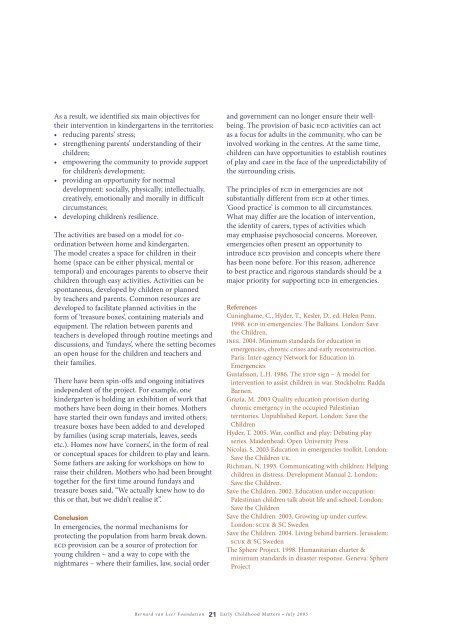Responses to young children in post-emergency situations
Responses to young children in post-emergency situations
Responses to young children in post-emergency situations
Create successful ePaper yourself
Turn your PDF publications into a flip-book with our unique Google optimized e-Paper software.
As a result, we identified six ma<strong>in</strong> objectives for<br />
their <strong>in</strong>tervention <strong>in</strong> k<strong>in</strong>dergartens <strong>in</strong> the terri<strong>to</strong>ries:<br />
• reduc<strong>in</strong>g parents’ stress;<br />
• strengthen<strong>in</strong>g parents’ understand<strong>in</strong>g of their<br />
<strong>children</strong>;<br />
• empower<strong>in</strong>g the community <strong>to</strong> provide support<br />
for <strong>children</strong>’s development;<br />
• provid<strong>in</strong>g an opportunity for normal<br />
development: socially, physically, <strong>in</strong>tellectually,<br />
creatively, emotionally and morally <strong>in</strong> difficult<br />
circumstances;<br />
• develop<strong>in</strong>g <strong>children</strong>’s resilience.<br />
The activities are based on a model for coord<strong>in</strong>ation<br />
between home and k<strong>in</strong>dergarten.<br />
The model creates a space for <strong>children</strong> <strong>in</strong> their<br />
home (space can be either physical, mental or<br />
temporal) and encourages parents <strong>to</strong> observe their<br />
<strong>children</strong> through easy activities. Activities can be<br />
spontaneous, developed by <strong>children</strong> or planned<br />
by teachers and parents. Common resources are<br />
developed <strong>to</strong> facilitate planned activities <strong>in</strong> the<br />
form of ‘treasure boxes’, conta<strong>in</strong><strong>in</strong>g materials and<br />
equipment. The relation between parents and<br />
teachers is developed through rout<strong>in</strong>e meet<strong>in</strong>gs and<br />
discussions, and ‘fundays’, where the sett<strong>in</strong>g becomes<br />
an open house for the <strong>children</strong> and teachers and<br />
their families.<br />
There have been sp<strong>in</strong>-offs and ongo<strong>in</strong>g <strong>in</strong>itiatives<br />
<strong>in</strong>dependent of the project. For example, one<br />
k<strong>in</strong>dergarten is hold<strong>in</strong>g an exhibition of work that<br />
mothers have been do<strong>in</strong>g <strong>in</strong> their homes. Mothers<br />
have started their own fundays and <strong>in</strong>vited others;<br />
treasure boxes have been added <strong>to</strong> and developed<br />
by families (us<strong>in</strong>g scrap materials, leaves, seeds<br />
etc.). Homes now have ‘corners’, <strong>in</strong> the form of real<br />
or conceptual spaces for <strong>children</strong> <strong>to</strong> play and learn.<br />
Some fathers are ask<strong>in</strong>g for workshops on how <strong>to</strong><br />
raise their <strong>children</strong>. Mothers who had been brought<br />
<strong>to</strong>gether for the first time around fundays and<br />
treasure boxes said, “We actually knew how <strong>to</strong> do<br />
this or that, but we didn’t realise it”.<br />
Conclusion<br />
In emergencies, the normal mechanisms for<br />
protect<strong>in</strong>g the population from harm break down.<br />
ecd provision can be a source of protection for<br />
<strong>young</strong> <strong>children</strong> – and a way <strong>to</strong> cope with the<br />
nightmares – where their families, law, social order<br />
and government can no longer ensure their wellbe<strong>in</strong>g.<br />
The provision of basic ecd activities can act<br />
as a focus for adults <strong>in</strong> the community, who can be<br />
<strong>in</strong>volved work<strong>in</strong>g <strong>in</strong> the centres. At the same time,<br />
<strong>children</strong> can have opportunities <strong>to</strong> establish rout<strong>in</strong>es<br />
of play and care <strong>in</strong> the face of the unpredictability of<br />
the surround<strong>in</strong>g crisis.<br />
The pr<strong>in</strong>ciples of ecd <strong>in</strong> emergencies are not<br />
substantially different from ecd at other times.<br />
‘Good practice’ is common <strong>to</strong> all circumstances.<br />
What may differ are the location of <strong>in</strong>tervention,<br />
the identity of carers, types of activities which<br />
may emphasise psychosocial concerns. Moreover,<br />
emergencies often present an opportunity <strong>to</strong><br />
<strong>in</strong>troduce ecd provision and concepts where there<br />
has been none before. For this reason, adherence<br />
<strong>to</strong> best practice and rigorous standards should be a<br />
major priority for support<strong>in</strong>g ecd <strong>in</strong> emergencies.<br />
References<br />
Cun<strong>in</strong>ghame, C., Hyder, T., Kesler, D., ed. Helen Penn.<br />
1998. ecd <strong>in</strong> emergencies: The Balkans. London: Save<br />
the Children.<br />
<strong>in</strong>ee. 2004. M<strong>in</strong>imum standards for education <strong>in</strong><br />
emergencies, chronic crises and early reconstruction.<br />
Paris: Inter-agency Network for Education <strong>in</strong><br />
Emergencies<br />
Gustafsson, L.H. 1986. The s<strong>to</strong>p sign – A model for<br />
<strong>in</strong>tervention <strong>to</strong> assist <strong>children</strong> <strong>in</strong> war. S<strong>to</strong>ckholm: Radda<br />
Barnen.<br />
Grazia, M. 2003 Quality education provision dur<strong>in</strong>g<br />
chronic <strong>emergency</strong> <strong>in</strong> the occupied Palest<strong>in</strong>ian<br />
terri<strong>to</strong>ries. Unpublished Report. London: Save the<br />
Children<br />
Hyder, T. 2005. War, conflict and play: Debat<strong>in</strong>g play<br />
series. Maidenhead: Open University Press<br />
Nicolai, S. 2003 Education <strong>in</strong> emergencies <strong>to</strong>olkit. London:<br />
Save the Children uk.<br />
Richman, N. 1993. Communicat<strong>in</strong>g with <strong>children</strong>: Help<strong>in</strong>g<br />
<strong>children</strong> <strong>in</strong> distress. Development Manual 2. London:<br />
Save the Children.<br />
Save the Children. 2002. Education under occupation:<br />
Palest<strong>in</strong>ian <strong>children</strong> talk about life and school. London:<br />
Save the Children<br />
Save the Children. 2003. Grow<strong>in</strong>g up under curfew.<br />
London: scuk & SC Sweden<br />
Save the Children. 2004. Liv<strong>in</strong>g beh<strong>in</strong>d barriers. Jerusalem:<br />
scuk & SC Sweden<br />
The Sphere Project. 1998. Humanitarian charter &<br />
m<strong>in</strong>imum standards <strong>in</strong> disaster response. Geneva: Sphere<br />
Project<br />
B e r n a r d v a n L e e r Fo u n d a t i o n 21 E a r l y C h i l d h o o d M a t t e r s • Ju l y 2 0 0 5
















